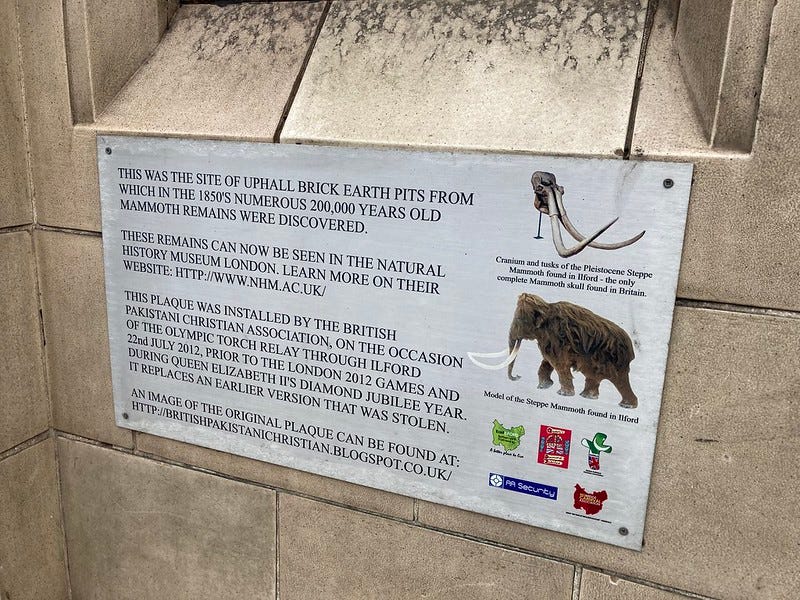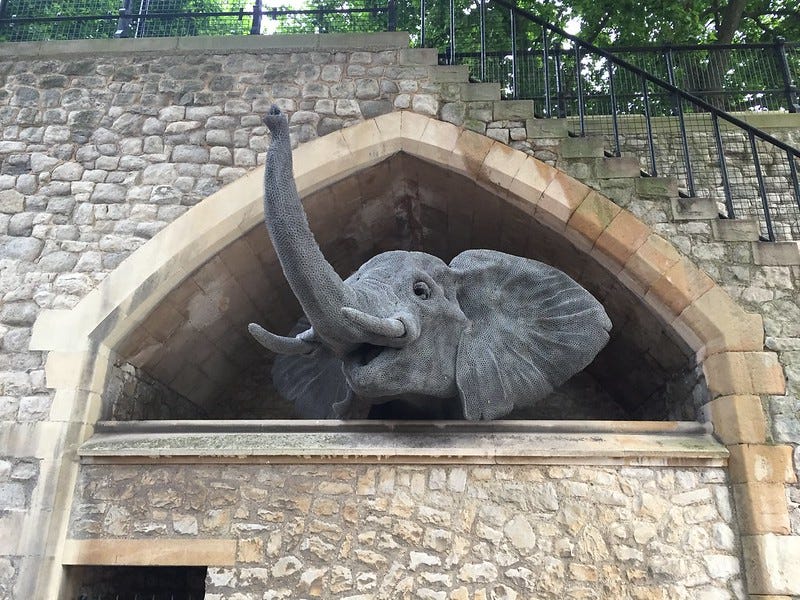Welcome to your rejigged Friday newsletter. This is the new home for the History Radar, our guide to upcoming events that delve into London history. That’s followed by a jumbo-feature in which (sticking with the animal-theme I started with Wednesday’s horsefest) I look at the history of elephants in London — from prehistoric beasts, to a bizarre stampede on the Embankment, to the London elephant that got eaten. Like the elephants that once carried young zoo visitors on their backs, it’s quite a ride.
🐘🐘🐘🐘🐘🐘🐘🐘🐘🐘🐘🐘🐘🐘🐘
History Radar
⛪️ 🎉 STREET 200: Not a celebration of a thoroughfare, but of George Edmund Street. 2024 marks 200 years since the birth of this under-appreciated architect, most famous for the neo-Gothic Royal Courts of Justice on Strand. Various events are planned throughout the year including a talk (online or in person) on 26 March, a tour of his redbrick church St Mary Magdalene, Paddington on 11 April, and a visit to the Guards Chapel, Wellington Barracks on 15 May. Full details here.
📚👣 LITERARY FOOTPRINTS: We’re about to enter the final week of the Literary Footprints festival, which has a programme of walking tours themed on books, authors and the like. Picks this week include a tour of Ian Nairn's London around Westminster, and a route following Daniel Defoe's account of the plague of 1665.
🏠🚶🏾♀️OXFORD HOUSE TOUR: 26 March offers another chance to take a guided tour of Oxford House in Bethnal Green, which includes access to its archives, secret chapel, and rooftop viewpoint, as well as a chance to hear about its history from Victorian beginnings to both world wars, to a visit from Gandhi.
🌟🚶🏽♂️GAS LIGHTS: With the nights getting shorter and the clocks about to change, 27 March is your last chance to join one of Jane Parker's wonderful London by Gaslight tours. The two-hour walk explores the history of gas lighting in Westminster, and points out some of the still-functioning gas powered lamps in the area.
🍫🏠 CHOCOLATE HOUSE: Catch a new historical exhibition is the Old Royal Naval College, which explores how chocolate was involved in the revival of Greenwich. Chocolate House Greenwich looks at the impact the brown stuff had on Georgian society when it started arriving from South America, and includes a recreation of the Tosier Chocolate House which was located in nearby Blackheath. 29 March-3 November
💂🏽♀️💂♂️GUARDS MUSEUM: Ever been to The Guards Museum on Birdcage Walk? If not, Saturday 30 March is an excellent time to do so. The Westminster museum is offering half-price entry for its Women's History Month celebrations. Events throughout the day include a chance to meet the women currently serving in Wellington Barracks, and try on a genuine guard’s uniform.
🐘🐘🐘🐘🐘🐘🐘🐘🐘🐘🐘🐘🐘🐘🐘
Every Interesting Elephant Who Ever Came to London
Elephants were once indigenous to London. Well… to the area that would become London. Their prehensile noses were snuffling through the foliage long before the first human settlement.
Ice sheets eventually drove them away but, in more recent centuries, they’ve returned in droves as part of circuses, novelty acts, zoos and menageries, and even as royal gifts. They can’t help but make a big impression. As I browsed through the archives, I found tales of drunken elephants, rampaging elephants, plummeting elephants, influential elephants and even a tasty elephant. I can’t list them all (that would be a mammoth task) but below are what I reckon are the most interesting elephants in London’s history.
But first… prehistory
Were you to take your time machine and wander along the River Roding in Ilford 200,000 years ago, you might stumble across a dying mammoth. Remains of the creature, including the only complete mammoth skull found in Britain, were discovered here in Victorian times. Elephant and mammoth fossils have also been found beneath Trafalgar Square and Regent Street, while the Museum of London holds an elephant’s foot, unearthed in Rainham.
AD 43: Roman invasion?
London’s indigenous elephants died out tens of thousands of years ago. We’d see no further trunksters until the dawn of the Roman period in AD 43. According to many accounts, Emperor Claudius made use of war elephants during his invasion of Britain that year. Or did he? The claim rests upon the history of Cassio Dio who was writing over 150 years after the event. No other strong evidence exists for pachydermic intrusion in the first century. Even if the elephants did come, there’s no reason to assume they ventured to the future site of London, which was just one of many small staging posts at the time.
1255: Drunken gift elephant
The first properly recorded elephant in the city arrived in 1255 when Louis IX of France gifted an elephant to Henry III (who probably guessed what he was getting from the unusual shape of the giftwrap). The poor creature expired two years later after drinking too much wine (this is true). Still, while it was here, it became the star attraction at the Tower of London's menagerie — a kind of early zoo for privileged people. The elephant is today commemorated with one of Kendra Haste's magnificent wire sculptures (above), which nestle in unlikely corners of the Tower.
1809-1826: Chunee and Co
The absurdly powerful East India Company brought a trio of Indian elephants to London between 1809 and 1811. All three were used/abused for public spectacle. Chunee, the most celebrated, was initially put to work on the Covent Garden stage, performing along such notables as Edmund Kean. The animal was then moved to Exeter Exchange, a hideously cramped menagerie on Strand. He was trapped here for over a decade, getting increasingly irascible. Things came to a nasty head in 1826 when Chunee fatally turned on one of his keepers. A few days later, soldiers were brought in to shoot the unfortunate animal. 152 musket balls later, and the elephant still stood. He was eventually finished off with a hand weapon.
1827: A therapeutic elephant in Chiswick
A year after Chunee’s brutal death, a much tenderer elephant story was unfolding in west London. The Duke of Devonshire had acquired an Indian elephant called Sadi for his palatial Chiswick House. The elephant would roam the gardens, entertaining guests with her ability to uncork bottles and turn door handles. She had many celebrity admirers. These included Prime Minister George Canning who spent a chunk of his final months attempting to recuperate at Chiswick House, where he was ‘much amused’ by the beast. The trunk couldn’t stop the truncation of his tenure. Canning died soon after, having served just 119 days as PM (the shortest stint ever, until Liz Truss knocked that one out of the park).
1831: First elephant at London Zoo
The very first elephant to arrive at London Zoo walked there from the East India Docks in May 1831. The poor animal had been penned up on a ship for nine months during a journey from Madras to London that somehow also took in China. Named ‘Jack’, he was a popular attraction at the zoo, except among bonneted ladies who were relieved of their headgear by a curious trunk on more than one occasion.






